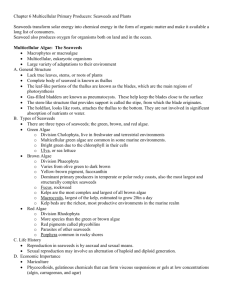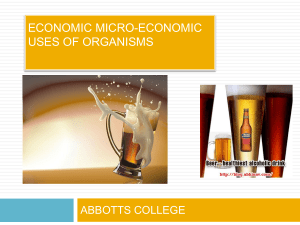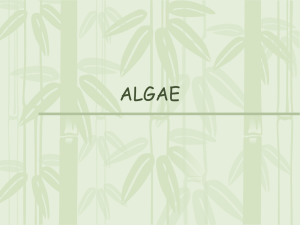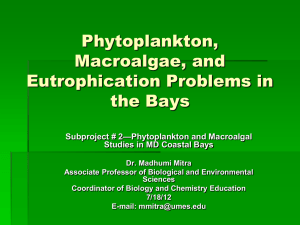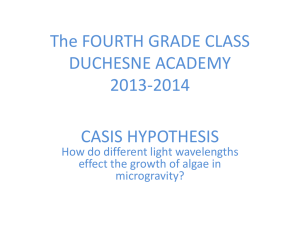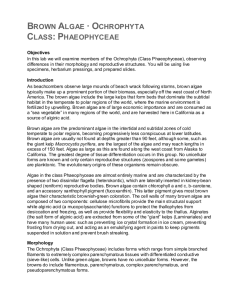File
advertisement
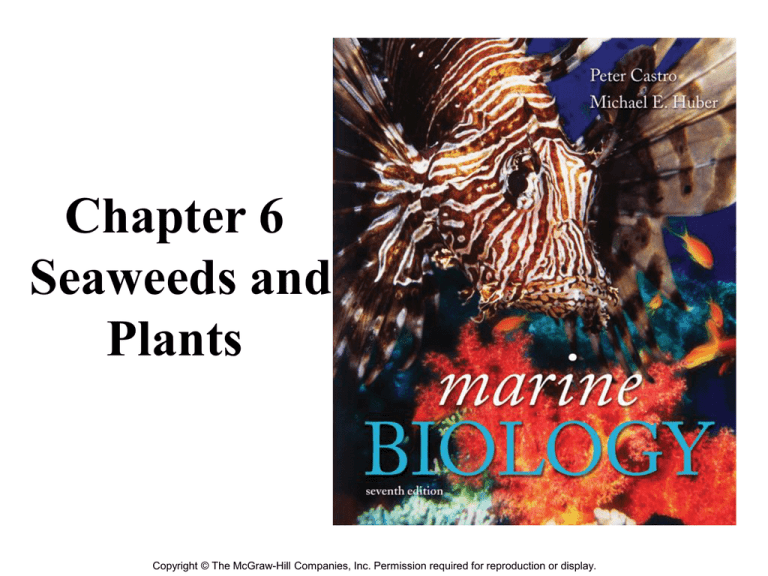
Chapter 6 Seaweeds and Plants Copyright © The McGraw-Hill Companies, Inc. Permission required for reproduction or display. Seaweeds and plants: 1.multicellular 2.primary producers photosynthesis 3.important as source of: chemical energy oxygen 4.eukaryotes Primary producers : organisms that manufacture organic matter from CO2 • Seaweeds: – Macrophytes or macroalgae – Classification based on: •Structure •Types of pigment •Food products they store – All seaweeds are algae, but all algae aren’t seaweeds! •Seaweeds are not plants! – Plants have a vascular system •Tissues for transporting water, nutrients and the products of photosynthesis •A reproductive system with flowers •True leaves, stem and roots Fig. 6.1 General structure Thallus Complete body General Structure of seaweeds • Thallus – The complete body – filament, thin leafy sheet, or giant kelp – Water and nutrients picked up across the surface • Holdfast – Root like attaches thallus to the sea bottom – Not for absorption, can’t penetrate sand or mud • Stipe – Stemlike structure for support – Pneumatocysts •Gas filled bladders •Keep blades close to surface • Blades – Leaflike flattened portions – Large surface area – Site of photosynthesis • Not true leaves: no veins, upper and lower surfaces the same • 3 types of algae Green, brown and red algae • Green algae – Phylum Chlorophyta – Freshwater, terrestrial and marine • About 10% of 7,000 species are marine – Simple thallus • May be filamentous (branched or unbranched) • May form sheets (Ulva) – Pigments and food reserves like land plants • Pigments: chlorophyll a, b and carotenoids • Color not masked by other pigments (bright green!) • Stores food as starch. Fig. 6.2 Ulva, or sea lettuce, Green algae, common on rocks where fresh water meets the sea. Fig. 6.3 Dead man’s fingers (Codium fragile) Forms branched clumps on rocky shores Chloroplasts remain alive and photosynthesize in sea slugs that feed on the seaweed • Calcareous green algae – Thallus of numerous segments – Deposits calcium carbonate – Plays a role in the formation of coral reefs • Brown Algae – Phylum Phaeophyta – Colors from olive green to dark brown – Yellow brown pigments + chlorophyll • Fucoxanthin – 1500 marine species – Dominant primary producers on temperate and polar rocky coasts – Largest seaweeds – Structurally most complex seaweeds Fucus Rockweed, or wrack, In Atlantic and Pacific temperate waters • Sargassum (sargasso weed) – In warm waters • Gulf of Mexico • California • Sargasso Sea (north of West Indies) • Natural absorbent for heavy metals – Used to clean industrial waste Fig. 6.4 Padina, a brown algae, produces clusters of flat bladfes that are rolled into circles. Fig. 6.5 Spiral rockweed, common on rocky shores of the Atlantic coast Fig. 6.6 Knotted rockweed North America and European coasts of the North Atlantic Brown algae! Fig. 6.7 Seapalm, a brown algae, a species of kelp, common to rocky shores with heavy wave action Pacific Coast of North America Fig. 6.8 Giant kelp: Macrocystic pyrifera • Kelp -largest and most complex brown algae • • • • Grow below tide level Temperate and subpolar latitudes Provide food and shelter for many organisms May be a single blade (Laminaria) – Harvested for food • May be ribbed (Alaria) – Up to 25 m long (82 ft) • Largest Pacific kelps grow just below lowest tide level – Bullkelp (Nereocystis) – Macrocystis – largest • Form kelp beds or forests (Monterey Bay Aquarium) • Harvested by chopping off the tops • Red Algae – Phylum/division: Rhodophyta – Red pigments mask chlorophyll • Phycobilin – – – – Shallow-water marine environments Harvested for food Most are filamentous Some are heterotrophic Fig. 6.9 Porphyra, a red algae, Inhabits temperate, polar, and tropical rocky shores. Fig. 6.10 Coralline red algae deposits calcium carbonate in their cell walls. May be encrusting on rocks - help develop coral reefs. Reproduction in Algae Asexual • Fragments of the thallus can grow into new individuals – Sargassum Sexual • Meiosis – Produces (1n) gametes • Gametes from two individuals fuse – Makes unique genetic combinations • Male and female gametes can form on the same thallus SPORES • Specialized cells – Dispersing to new locations • Some have flagella - zoospores – Protection through unfavorable conditions – A diploid, spore-producing generation is called a sporophyte. – A haploid, gamete-producing generation is called a gametophyte. Fig. 6.11 C C Only one thallus and it is diploid . Fig. 6.12 Fig. 6.13 Fig. 6.14 Fig. 6.15 Page 111 Harvesting kelp in Japan TABLES Tab. 6.1
